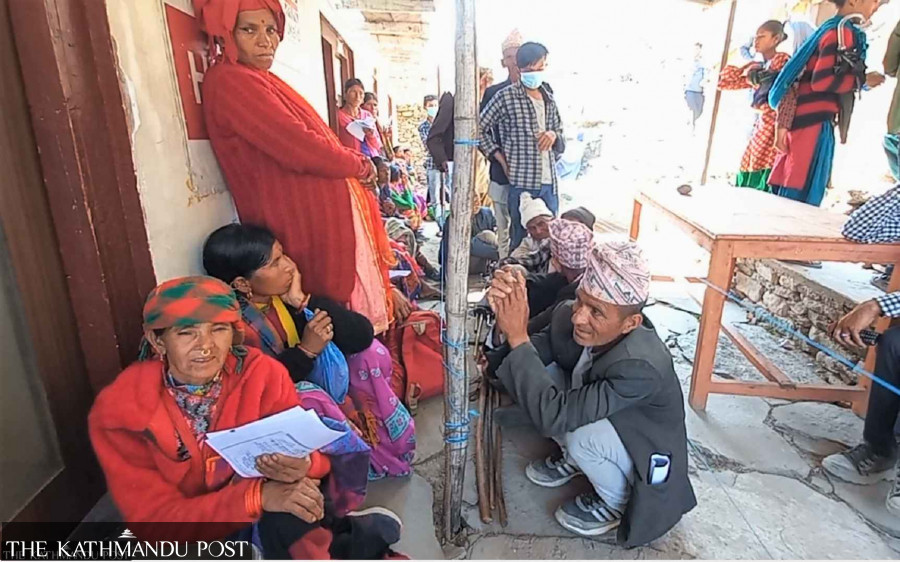
Senior citizens wait outside a bank in Bajura to collect their social security allowance in this photo taken earlier this year. Post File Photo
The government’s expenditure on social security allowance is set to nearly double in two years by the end of the next fiscal year 2022-23, raising questions about sustainability of such cash transfer schemes.
Besides direct cash transfer, the government spends heavily on various other social security schemes, including medical insurances and subsidies which also create pressure on the state coffers. And the government’s spending on such schemes is going up at a time when it has been failing to collect the targeted revenue and is increasingly relying on domestic and external loans for financing the public expenditure.
While presenting the budget for the fiscal year 2021-22, the erstwhile KP Sharma Oli government increased all social security allowances by 33 percent, including the elderly allowance to Rs4,000 per month from Rs3,000 per month.
The Sher Bahadur Deuba-led coalition government, which came to power in July last year, then further took another decision on the elderly allowance.
In the fiscal year 2020-21, the government spent Rs 68.61 billion on social security allowances, according to the Department of National ID and Civil Registration.
“The expenditure is expected to rise over Rs100 billion in the current fiscal year 2021-22,” said Anuj Bhandari, director at the department.
In what looks like an extremely populist programme targeting the upcoming elections, the Deuba-led government reduced the eligibility age for receiving the elderly allowance to 68 years from earlier 70 years.
“As a result, more than 300,000 beneficiaries aged between 68 and 70 years are expected to be added,” said Bhandari. “So the total expenditure for social security allowance is expected to remain around Rs120 billion in the next fiscal year 2022-23.”
It means projected expenditure in social security allowance in the fiscal year 2022-23 is almost double the amount the government spent under the header in the fiscal year 2020-21.
“The question here is not whether the government took a wrong decision by decreasing the eligibility age for the elderly allowance,” said Bidyadhar Mallik, former minister and finance secretary. “It is the question of whether the state has the capability to sustain such a large scale rise in social security allowance.”
According to him, he would support the increased special security spending provided this is relative to the country’s prosperity.
Nepal’s expected per capita income for the current fiscal year stood at $1,381, according to the Central Bureau of Statistics which is one of the lowest in South Asia and the world.
The government made a downward revision of its revenue target in the last two consecutive fiscal years. There is doubt that the government will collect targeted revenue in the next fiscal year as it has been forced to ban imports of major revenue-generating items, including automobiles, amid depleting foreign exchange reserves.
With the government revenue becoming increasingly inadequate to support the expenditure plan, the government has been taking loans from domestic and external creditors. As a result, the country's debt reached a record high of Rs1.85 trillion as of the third quarter of the current fiscal year from just Rs698 billion in the fiscal year 2016-17, according to the Public Debt Management Office.
With the government liability on unproductive sectors including the social security allowance, increasing, it is increasingly facing a shortage of financial resources to implement major development projects.
The government liability in the social security allowance is rising particularly due to three factors—increasing number of beneficiaries because of certain constitutional guarantees, decreasing eligibility age for elderly allowance amid increasing life expectancy of Nepali people and the government tendency to increase social security allowance as per their election manifestos.
For example, the left alliance of the CPN-UML and the CPN (Maoist Centre) announced an increased elderly allowance to Rs5,000 per month and the UML-led government hiked it to Rs4,000 per month. As per the Nepali Congress’s manifesto to reduce eligibility age for elderly allowance before the local elections in 2022, the government reduced the eligibility age through next fiscal year’s budget.
“When life expectancy rises, the number of beneficiaries automatically rises,” said Bhandari. “More beneficiaries will be added when the eligibility age for elderly allowance is decreased.”
The government’s decision to reduce eligibility age for elderly allowance comes at a time when the average life expectancy of Nepalis has gone up. In 2020, Nepal’s average life expectancy stood at 71 years, up from 68 years in 2010, according to the World Bank. There were 1.31 million beneficiaries aged above 70 years in fiscal 2020-21 which accounts for over 38 percent of total beneficiaries, being the single largest beneficiary group, according to the department.
Likewise, people aged 60 years and above; those aged 60 and above from the Karnali region and Dalit communities; helpless widows and single women; people with disabilities; people from endangered communities and children from some specific regions and communities are also entitled to social security allowances.
According to Bhandari, the number of beneficiaries reached 3.6 million this fiscal year compared to 1.56 million in 2010-11.
The number of beneficiaries increased by 393,219 in fiscal year 2020-21. Since fiscal 2017-18, the number of beneficiaries has been rising by around 300,000 a year, according to the department. Now, the number of beneficiaries of social security allowance accounts for over 12 percent of the country's 29.19 million population.
Along with the rising number of beneficiaries, the cost of social security allowance is also on the rise.
Besides cash transfers, the government also spends on health insurance for citizens, pensions, retirement benefits, financial assistance for natural disaster victims and scholarships for targeted groups.
“There are 42 types of social security schemes currently and combined resources needed under these schemes is around Rs255 billion,” Rameshore Khanal, also a former finance secretary, told the Post in August last year.
“This means over 25 percent of the government’s revenue target for the current fiscal year 2021-22 will go to social security schemes. This is still high compared to even the developed countries.”
In the last fiscal year 2020-21, around 30 percent of the total revenue was spent on social security schemes. The federal government in 2020-21 collected Rs829 billion in revenues.
“If revenue collection drops sharply due to some reasons in the future, we may head towards an economic crisis like the one Greece went through, if the spending on social security is unrestrained,” Khanal said.
According to a World Bank report, overall public spending on social protection has been rising rapidly in Nepal in a decade from fiscal 2010-11 to fiscal 2019-20. The government spending on overall social protection was Rs26 billion in fiscal 2010-11 which surged many folds to Rs189 billion in fiscal 2019-20, according to the report titled ‘Review of Public Expenditure and Assessment of Social Assistance Programme.’
The previous Oli-led government announced the rise in social security allowance in the middle of the Covid-19 as it had announced new parliamentary elections for November last year after dissolving the House. Due to the impact of Covid-19, the country’s economy was already in bad shape.
“The government not only lowered the eligibility age for elderly allowance which will create a new burden on the state coffer, it also hiked the salary of government employees by a whopping 15 percent,” said Mallik. “The government increased recurrent expenditure in a big way at a time when the country’s economy is facing a crisis. So, these are not fiscally responsible acts of the government.”
The government, however, has not allocated enough budget for social security allowance despite decreasing the eligibility age for elderly beneficiaries.
According to the Finance Ministry, the government has allocated Rs105.70 billion for social security allowance for next fiscal.
“We may require around Rs120 billion because of the potential rise in the number of beneficiaries,” said Bhandari.
The social security scheme was launched in 1994-95 by the government led by Manmohan Adhikari, a UML leader. The scope of the scheme, which started by providing Rs100 per month to the elderly, was gradually expanded to include single women and people with disabilities in 1996-97. Members of communities on the verge of extinction and disabled persons were also added to the list in 2008-09. Dalit children made it to the list in 2010-11 while widows were included in 2011-12. Dalits from the Karnali region were added to the list in 2016-17 and children from 15 districts with low human development index values were made beneficiaries of cash transfers in 2018-19. The number of such districts has gone up to 26 this fiscal year.
The government still needs to put a number of groups on the list of beneficiaries as per the Social Security Act-2018.
For instance, indigent people (persons who earn less than what is specified by the government in a notice published in the Nepal Gazette) and helpless women legally separated from their husbands are yet to be listed as beneficiaries despite legal provisions. Currently, only divorced women aged 60 years and above are getting social security allowance.
“If our economy does not grow and the financial burden of social security continues to rise, it is not sustainable,” said Mallik. “It is better to provide social security under a single window and make the scheme contribution based as far as possible.”













